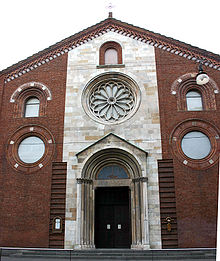San Giovanni in Conca (Crypt), Milan
This article has multiple issues. Please help improve it or discuss these issues on the talk page. (Learn how and when to remove these template messages)
|
| Crypt of San Giovanni in Conca | |
|---|---|
 Current remains of San Giovanni in Conca visible from surface. | |
| Type | Church remains |
| Location | Milan (Piazza Missori),Italy |
| Coordinates | 45°28′12″N 9°10′43″E / 45.47000°N 9.17861°E |
| Architectural style(s) | Romanesque |
| Governing body | Touring Club Italiano |
| Owner | Milan municipality |

San Giovanni in Conca is a crypt of a former basilica church in Milan, northern Italy. It is now located in the centre of Piazza Missori.
History
The basilica of San Giovanni in Conca dates from the 4th century, and was located in a residential quarter of the ancient city. Remains of the mosaic pavement of this original edifice are now in the Archeological Museum of Milan.
The church was rebuilt in the 11th century, but was destroyed by
In 1531, Duke Francesco II Sforza donated it to the Carmelites, who erected a campanile which was utilized as astronomical observatory in the 19th century. The church was deconsecrated by the Austrians and closed by the French in the late 18th century.

In 1879, the church was shortened to allow the construction of the current Via Mazzini; in the occasion, the Gothic façade was attached to the apse. San Giovanni in Conca was then sold to the Waldensians who, when the church was demolished (1949), rebuilt the façade on their new church in Via Francesco Sforza. Works of demolition were however halted just before their end, leaving only the crypt and remains of the apse.
Remains
San Giovanni in Conca ruins include the only extant example of Romanesque crypt in Milan. It houses archaeological findings which illustrates the church's history.
Over the crypt are remains of the apse walls, with a single window and blind arches typical of the Milanese Romanesque.
Artworks from the church which are now in the Sforzesco Castle include, apart the two aforementioned funerary monuments, two figures from an Annunciation (11th century), some Romanesque capitals and frescoes from the 14th century.
References
- Page about the church's history (in Italian)


